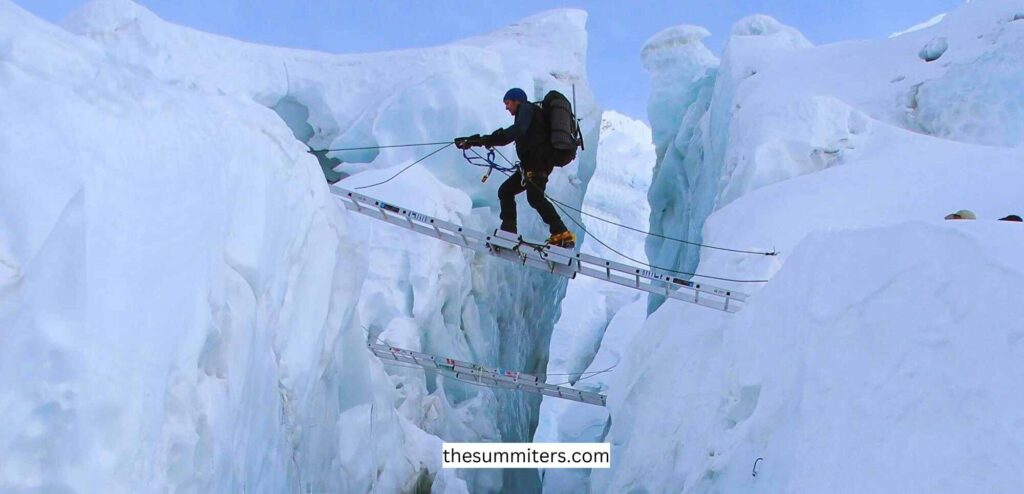
Sherpas are the remarkable ethnic group mainly hailing from the mountainous regions of Nepal in South Asia. They are Renowned for exceptional mountaineering skills and dedication in high altitude environments, The Sherpas have achieved global recognition as the real heroes of the world’s toughest peaks, Specially the Himalayas. The Name “Sherpa” has become identical with experienced mountain guides and Posters who navigate the treacherous terrain of these tall summits, assisting mountaineers from around the world in their quests to conquer the world’s highest peaks.
The Sherpas’ rich cultural heritage, deeply intertwined with the majestic landscapes they call home, encompasses a distinct way of life, language, and spiritual beliefs. Even so facing immense challenges in the harsh mountain environments, Sherpas have demonstrated unparalleled courage and adaptability, making them indispensable figures in the world of mountaineering. This introduction sets the stage for a closer exploration of the Sherpa people, their historical origins, and their pivotal role in the realm of high-altitude mountaineering.
The Sherpas: Masters of the Mountains
Historical Origins and Heritage
The Sherpas, renowned Himalayan mountaineers, trace their origins to Tibet. Centuries ago, they migrated to Nepal’s Solu-Khumbu region, bringing their Tibetan heritage and Buddhist beliefs. Their unique identity is shaped by their resilience and adaptation to the rugged mountain environment. The Sherpa language, culture, and deep connection to Buddhism reflect their rich heritage. As farmers and herders, they’ve thrived amidst the towering peaks that define their homeland.
Tenzing Norgay: The First Summit
Tenzing Norgay, a legendary Sherpa, made history in 1953 as part of the first successful ascent of Mount Everest with Sir Edmund Hillary. His achievements are not only marked a turning point in mountaineering but also focused on the Sherpas’ extra ordinary skills. Tenzing Norgay’s Achievements continues to inspiring the mountaineers from worldwide, the doors opening to countless high altitude adventures in the Himalayan Rang.

Here is the List of Some Legacy Sherpas
Tenzing Norgay
Ang Rita Sherpa
Apa Sherpa
Phurba Tashi Sherpa
Lhakpa Gelu Sherpa
Pasang Lhamu Sherpa
Pemba Dorje Sherpa
Nawang Gombu
Nima Tenji Sherpa
Dawa Geljen Sherpa
The Sherpas’ Role in Mountaineering Expeditions
The Sherpas playing a pivotal role in the world of mountaineering Summits. Their experience in navigating the risky terrains of the Himalayas and other towering peaks is unparalleled. Sherpas become as the backbone of high-altitude climbing, Porting and assisting mountaineers from across the World in their quests to conquer some of the planet’s Vertical summits. Their personal knowledge of the mountains, accumulated over several generations, is essential in ensuring the safety and accomplishment of these expeditions.
Guiding and Ensuring Safety
Sherpas serve as expert guides and guardians of safety on the treacherous paths of the world’s highest peaks. They lead climbers through crevasse-laden glaciers, across precarious icefalls, and up steep, snow-covered slopes, all while meticulously assessing weather conditions and the physical well-being of the team. Their role goes beyond navigation; they provide crucial support, offer encouragement, and make swift decisions to mitigate risks. Sherpas’ unwavering commitment to safety has saved countless lives and made ambitious mountaineering endeavors more achievable.
Porters Extraordinaire and Base Camp Operations
In addition to their guiding roles, Sherpas are also renowned as porters extraordinaire. They shoulder the immense logistical burden of ferrying equipment, supplies, and provisions to the high-altitude base camps. These camps serve as crucial hubs for acclimatization and planning, and Sherpas’ efficiency in establishing and maintaining them is unmatched. They brave extreme conditions and grueling workloads to ensure that climbers have the necessary resources for a successful ascent. The Sherpas’ dedication to both their guiding and logistical responsibilities has solidified their indispensable status in the world of mountaineering.
The Perils and Difficulties of High Altitude Hiking
Highaltitude mountaineering is the pursuit that demands unwavering drive and strength in the face of beyond compare risks and challenges. At High altitudes, the mountaineer’s body is pushed to its limits, fighting falling temperatures, lack of oxygen, and unwanted weather changings. The air is at these heights can lead to high altitude sickness, severe frostbite, and even cerebral or the pulmonary edema, life threatening conditions that mountaineers must protect themselves all the time. Add these technical difficulties of navigating crevasses, icefalls, and steep, avalanche, prone slopes, and it becomes witness that high altitude mountaineering is a risky attempt that requires very careful planning, extensive training, and the guidance of experienced climbers.

Perils of the Peaks
The world’s tallest peaks, particularly are in the Himalayas, are known for their unforgiving nature. Mountaineers have to face the all time risk of avalanches, rockfalls, and sudden weather changes, which can transform a clear day into a deadly blizzard within minutes. The inherent dangers of these towering summits are magnified by the remoteness of many climbing routes, making timely rescue operations exceedingly difficult. These challenges, combined with the immense physical and mental strain of high-altitude climbing, underscore the gravity of the risks involved in pursuing the world’s loftiest summits.
Recognizing the Risks for Sherpas
While mountaineers have accept the risks associated with high altitude expedition, it is essential to recognize that Sherpas, who are serving as guides and personal porters, face these risky situations as part of their daily life. Their roles on expeditions require them to repeatedly navigate treacherous terrain, often carrying heavy loads, all while exposed to the same environmental hazards as climbers. Sherpas are not only experts in the safety and success of mountains expeditions but also subject to the same life threatening conditions, demonstrating exceptional courage and resilience. Acknowledging these risks is crucial in understanding and appreciating the contributions and sacrifices made by the Sherpa community in the world of high-altitude mountaineering.
Achievements and Recognition
The Sherpa Peoples, often known as the backbone of high altitude mountaineering, has built up a remarkable legacy of achievements and acquired global recognition for their extra ordinary contributions to the world of mountains expedition. Sherpas are acclaimed not only for their exceptional climbing mastery but also for their steady dedication to navigating and ensuring the safety of mountaineers from around the world. Their deep knowledge of the Himalayan terrain and their ability to navigate treacherous conditions have made them indispensable figures in the realm of extreme altitude climbing.
Everest Conquests and Historic Ascents
Sherpas have played a central role in countless historic ascents of the world’s highest peak, Mount Everest. From Sir Edmund Hillary and Tenzing Norgay’s groundbreaking expedition in 1953 to the numerous successful summits in the modern era, Sherpas have been the guiding force behind these achievements. Their resilience and expertise have made it possible for climbers to reach the rooftop of the world. Sherpas have not only guided others to the summit but have also set numerous records themselves, showcasing their exceptional mountaineering abilities.
Awards and Honors
In remembrance of their exceptional contributions to the world of mountains expedition, Sherpas have received the numbers of awards and honors. These achievement reflect not only their remarkable climbing feats but also their promises to making the safety and success of those who seek to summit the world’s highest peaks. The climbing community and governments of Nepal and other nations have bestowed prestigious awards upon Sherpas, celebrating their indomitable spirit, selflessness, and unmatched skills as guides and climbers. These honors underscore the deep respect and admiration that the world holds for the Sherpa community and their pivotal role in high-altitude mountaineering.
The Sherpa Spirit: Beyond the Summits
The heart of the Sherpa people beats with a spirit that reaches far beyond the towering Himalayan peaks they call home. It’s a spirit deeply rooted in their connection to these majestic mountains, a resilient way of life, and a strong sense of community. While their mountaineering achievements are impressive, the Sherpa spirit isn’t limited to these feats; it shines through in their daily lives and their unwavering commitment to each other. It’s a spirit forged in the face of high-altitude challenges and nurtured by their enduring bond with the natural world.
Deep Connection to the Mountains
For the Sherpas, the mountains aren’t just a workplace; they hold a sacred place in their hearts, culture, and spirituality. These towering peaks are believed to be the homes of deities, and the Sherpas hold them in the highest reverence. The mountains provide more than just a livelihood; they offer a sense of identity and purpose. This connection is evident in the Sherpas’ profound knowledge of the terrain, their respect for its power, and their dedication to safeguarding these fragile environments.
Cultural Traditions and Festivals

Sherpa culture is a vibrant tapestry of traditions, rituals, and festivals that celebrate their unique way of life amidst the Himalayan heights. Festivals like Losar (New Year), Dumje (Sherpa harvest festival), and Mani Rimdu are lively expressions of their deep-rooted beliefs and values. These cultural celebrations bring communities together, weaving bonds of unity and resilience. Through dance, music, and age-old customs, the Sherpas pay homage to their ancestors, their beloved mountains, and their enduring spirit, ensuring that their rich cultural heritage thrives alongside the challenges of the modern world.
Beyond the Peaks: Sherpas in Popular Culture
Sherpas, often regarded as the unsung heroes of mountain exploration, have left an enduring imprint on popular culture. Their remarkable achievements amidst the world’s loftiest peaks have inspired a wealth of literary works, documentaries, and cinematic portrayals that celebrate their extraordinary contributions and the formidable challenges they confront in the Himalayas.
Books and Documentaries
The captivating stories of Sherpa bravery and resilience have found their way into numerous books and compelling documentaries. Authors and filmmakers have been drawn to the allure of Sherpa experiences, chronicling their high-altitude adventures, their vibrant cultural heritage, and their profound bond with the mountains. These creative endeavors have not only illuminated the Sherpa way of life but have also brought to the forefront their pivotal roles in the realm of mountain climbing. From gripping firsthand narratives of Everest expeditions to in-depth explorations of Sherpa culture, these literary and visual creations have deepened our understanding of the Sherpa community’s significance. Through these mediums, the Sherpa story has been woven into the global tapestry of human fascination.
Cinematic Portrayals
In the world of cinema, Sherpas have been featured in both documentaries and fictional films. Documentaries like “Sherpa” offer intimate glimpses into the lives of these mountain guides, shedding light on the myriad challenges they confront and the sacrifices they make to support climbers. Furthermore, Sherpas have been portrayed in fictional films that delve into their heroic contributions to mountaineering. These cinematic representations serve not only as sources of entertainment but also as tributes to the Sherpas’ valor and endurance amidst extreme conditions, making their narratives accessible and relatable to audiences across the world. Through these artistic mediums, the stories of the Sherpas have transcended the mountain ranges, resonating with people well beyond the peaks they call home.
Conclusion: Sherpas—Guardians of the Mountains
Deep within the towering embrace of the Himalayas, amidst peaks that seem to touch the heavens, the Sherpa community emerges as the unsung heroes and true protectors of mountaineering. Their unbreakable spirit, steadfast dedication to safety, and profound knowledge of the world’s loftiest summits have made them indispensable to climbers from every corner of the globe. On the other side the mountain’s reach, the Sherpas’ profound connection to these peaks, their vibrant cultural customs, and joyous festivals paint a portrait of a community deeply rooted in the land they cherish. Sherpas are not only professional mountaineers, they are the guardian of a historic heritage, and a way of life deeply embedded into the structure of the Himalayas. Their endowment to the world of mountaineering far beyond guiding and climbing, they stand as a living Legends of the human spirit’s enduring strength and the perpetual allure of Earth’s most majestic landscapes. The Sherpas aren’t merely legends of the mountains; they are the guardians of mountaineering, ensuring that the world’s loftiest summits remain accessible and secure for all who dare to dream of reaching them.